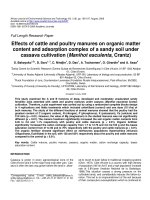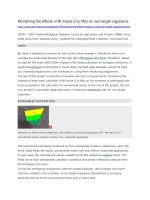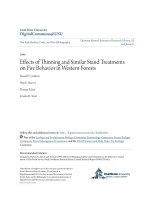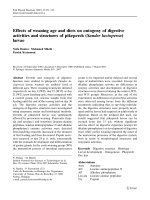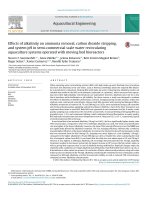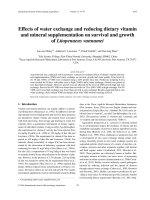Effects of lysine, methionine, threonine and tryptophan on growth performance and serum antibody titers to Gumboro disease of color-feathered chickens
Bạn đang xem bản rút gọn của tài liệu. Xem và tải ngay bản đầy đủ của tài liệu tại đây (263.06 KB, 6 trang )
29
Nong Lam University, Ho Chi Minh City
Effects of lysine, methionine, threonine and tryptophan on growth performance
and serum antibody titers to Gumboro disease of color-feathered chickens
Mai C. Duong1∗ , Dong D. Duong2 , & Huong T. N. Dang1
1
Department of Veterinary Biosciences, Nong Lam University, Ho Chi Minh City, Vietnam
2
Department of Animal Nutrition, Nong Lam University, Ho Chi Minh City, Vietnam
ARTICLE INFO
Research paper
Received: April 07, 2018
Revised: May 20, 2018
Accepted: June 10, 2018
Keywords
Antibody titer
Broiler chickens
Lysine
Methionine
Threonine
∗
Corresponding author
Duong Chi Mai
Email:
ABSTRACT
The experiment was conducted to determine the effects of four
amino acids (lysine, methionine, threonine and tryptophan) supplementation on growth performances and serum antibody titers
to Gumboro disease (IBD, infectious bursal disease) in broiler
chickens. Chicks were randomly assigned to 5 dietary groups (5
chicks/group as 12 replicates of 5 chicks) in a complete randomised experimental design. Group I served as control group,
was fed a diet without any supplementation. Groups II and III
were supplemented 10% of four amino acids (lysine, methionine,
threonine and tryptophan) of the recommended requirements
for 45 and 42 days, respectively. Meanwhile, Groups IV and V
were supplemented 20% of four amino acids (lysine, methionine,
threonine and tryptophan) of the recommended requirements for
45 and 42 days, respectively. The supplementation was started
at 3 days of age in chicks. The chickens were vaccinated against
Gumboro disease at day 12 and day 19. The antibody titer of the
chickens in each group was assayed using IBD anti-body ELISA.
Besides, the live body weight, average feed intake and feed conversion (FCR) were determined at 0, 21, 42 and 84 days of age.
The results showed no significant different between groups in
performance parameters such as body weight and FCR. However, the present work showed highest dose of lysine, methionine, threonine and tryptophan supplementation for 42 days may
be improved feed intake and immune response of chicken against
Gumboro disease vaccination.
Cited as: Duong, M. C., Duong, D. D., & Dang, H. T. N. (2018). Effects of lysine, methionine,
threonine and tryptophan on growth performance and serum antibody titers to Gumboro disease
of color-feathered chickens. The Journal of Agriculture and Development 17(3), 29-34.
1. Introduction
bursal disease (or Gumboro disease) is one of
the economically most important diseases that afIn order to be effective in chicken production, fects commercially produced chickens worldwide
preventive medicine, genetic selection and im- (Eterradossi & Saif, 2008). Chickens infected with
proved nutrition and management should be con- IBDV between 3 and 6 weeks of age mostly show
cerned carefully. Nutritional supplements (carbo- clinical signs and mortality accompanied with
hydrate, protein and fats) should be provided to bursal atrophy. According to Muller et al. (2003),
ensure the growth, repair of damaged tissues as strain and the amount of the virus, age and the
well as daily maintenance. However, deficiency or breed of chickens, the route of inoculation, the
excess of dietary protein or amino acids alters im- presence or absence of neutralizing antibodies,
mune responses (Payne et al., 1990). Infectious intercurrent primary and secondary pathogens
www.jad.hcmuaf.edu.vn
The Journal of Agriculture and Development 17(3)
30
and environmental and management factors affect the level of serious clinical signs in chicken. In
chicken, infected with IBDV can cause immunosuppression, which makes the birds vulnerable
to a variety of secondary infections chickens also
develop a poor immune response to vaccination
against other pathogens (Mazariegos et al., 1990).
Therefore, strict hygiene management and vaccination programmes have been used to prevent
IBD. For optimal growth and immune response,
lysine and methionine are required for protein
synthesis by mammals and avian species (Rubin
et al., 2007). Tryptophan can be considered as
a third limiting amino acid for poultry, followed
by methionine and lysine (Peganova et al., 2003).
According to Kidd & Hackenhaar (2006), tryptophan deficiency not only affects carcass quality
but it also impairs the synthesis of important neurotransmitters such as serotonin and melatonin.
Besides, threonine is a major component of intestinal mucin and plasma gamma-globulin in animals (Kim et al., 1999). Thus, the aims of this
study was to evaluate the effects lysine, methionine, threonine and tryptophan requirements on
growth performances and serum antibody titer to
Gumboro disease in broiler chickens.
2. Materials and Methods
A total of 300 day-old chicks (DOC) of color
feather breed named “Huynh De” were obtained
from Binh Minh breeder farm to use in all experiments. The chicks were weighed on arrival, and
randomly allocated into 5 equal groups with 12
replicates each (5 chicks per replicate). Feed and
water were provided ad libitum. The basal diet
(Table 1) was formulated to contain all essential
amino acids at recommended levels (NRC, 1984),
modified by Duong Duy Dong (unpublished materials). In addition, chemical composition of the
basal diet used in chicken feeding was shown in
Table 2. Group I served as control group, was
fed a basal diet without any supplementation.
Groups II and III were supplemented 10% of
four amino acids (lysine, methionine, threonine
and tryptophan) of the recommended requirements for 45 and 42 days, respectively. Meanwhile, Groups IV and V were supplemented 20%
of four amino acids of the recommended requirements for 45 and 42 days, respectively. The supplementation was started at 3 days of age in
chicks. The chicks were vaccinated against Newcastle disease on 4, 20 and 42 days of age; and
The Journal of Agriculture and Development 17(3)
Nong Lam University, Ho Chi Minh City
Gumboro diseases on 12 and 19 days of age. Response variables measured during the experiment
included body weight, body weight gain; feed intake, feed conversion ratio on day 0, 21 42 and
84 days of age. On 11, 18, 27, 34, 41, 49, 56, 63,
70, 77 and 84 days of age, five birds from each
group were chosen at random and blood samples
were collected from the brachial vein. Serum was
separated by centrifugation (3000 g, 15 min) and
antibody titre against IBD were performed using
commercially available ELISA kits (IDEXX, Labs
Inc., Westbrook, Maine, USA) according to manufacturer’s instructions. The data obtained were
analyzed by Tukey’s test and one-way analysis of
variance (ANOVA) using Minitab 16.0.A P value
< 0.05 was considered statiscally significant.
3. Results and Discussion
3.1. Growth performance
As shown in Table 3, the body weight and average daily gain of Group III was higher than those
at 84 days of age. However, no significant difference about the body weight and average weight
gain was found among treatment Groups. The
body weights of this study reached the standards
of Binh Minh company in which chickens at 100
days of age were gained from 1.7 to 1.9 kg (Vu,
2015). The highest food consumption in Group
I (control group) and the lowest of this found in
Group IV with the increment level of 20% for
45 days of 4-amino acid mixture supplementation
were also found. Compared with Control Group,
Groups I and II, it was observed that dietary
treatment Groups IV and V had significant effects
on the feed intake (P < 0.001) and feed conversion ratio (P < 0.05). Bouyeh (2012) also confirmed that the increment levels of 10%, 20% and
30% lysine and methionine would increase body
weight, cardiac and liver weight as well as decrease feed intake of chicken. On the contrary, the
increment level of 40% of these two amino acids
would decrease body weight of chicken. Rogers
& Pesti (1990) also reported that tryptophandeficient diets caused a reduction in weight gain;
but, the excess tryptophan in the diet caused a
numerical decrease in bird weight gain (Koelkebeck et al., 1991). Therefore, the standard and
the amount of amino acid consumed by the birds
have a great influence on weight gain and feed
intake (Teeter et al., 1993).
www.jad.hcmuaf.edu.vn
31
Nong Lam University, Ho Chi Minh City
Table 1. Ingredient composition of the experiment diets (basal diet)
Ingredients (%)
Corn
Rice bran I
Soybean meal 46
Fish oil
L-Lysin-HCl 98%
DL-Methionin
L-Threonin 98.5
L-Tryptophan 98
NaHCO3
Choline chloride 60
Antioxidants
Limestone powder
Premix BA112
Poison absorption
Herb extracts
Precursor creatine
DCP 18
Organic acids
Probiotics
0 - 21 days of age
63.219
5.791
23.175
2.460
0.212
0.210
0.100
0.029
0.817
0.120
0.020
1.186
0.250
0.100
0.015
0.060
2.086
0.100
0.050
22 – 42 days of age
63.513
2.387
26.129
2.500
0.135
0.249
0.210
0,097
0.820
0.120
0.020
1.170
0.250
0.100
0.015
0.060
2.077
0.100
0.050
43 – 84 days of age
62.930
28.796
2.500
0.353
0.790
0.249
0.117
0.035
0.805
0.120
0.020
1.157
0.250
0.100
0.015
0.060
2.065
0.100
0.050
Table 2. Chemical composition of the basal diet used in chicken feeding
Composition
Dry matter
Metabolisable energy
Crude protein
Crude lipid
Linoleic acid
Gross fiber
Total mineral
Calcium
Total phosphorus
Available phosphorus
Sodium
Chlorides
dEB
Total lysine
Total methionine
Total Met. + Cys.
Total threonine
Total tryptophan
Digestible lysine
Digestible methionine
Digestible Met.+ Cys.
Digestible threonine
Digestible tryptophan
Digestible leucine
Digestible isoleucine
Digestible valine
www.jad.hcmuaf.edu.vn
Unit
%
Kcal/kg
%
%
%
%
%
%
%
%
%
%
meq
%
%
%
%
%
%
%
%
%
%
%
%
%
0-21 days of age
87.699
2900.000
19.000
5.614
1.367
2.911
5.805
0.950
0.703
0.400
0.226
0.140
240.000
1.174
0.538
0.857
0.813
0.235
1.080
0.512
0.778
0.686
0.210
1.480
0.707
0.777
22 – 42 days of age
87.628
2900.000
18.000
5.651
1.259
2.975
5.899
0.950
0.719
0.400
0.230
0.134
240.000
1.090
0.489
0.797
0.758
0.189
1.000
0.464
0.720
0.635
0.166
1.416
0.665
0.738
43 – 84 days of age
87.581
2900.000
17.000
5.811
1.179
3.086
6.052
0.950
0.743
0.400
0.230
0.128
240.000
0.996
0.477
0.773
0.724
0.205
0.910
0.452
0.697
0.604
0.182
1.340
0.619
0.695
The Journal of Agriculture and Development 17(3)
32
Nong Lam University, Ho Chi Minh City
Table 3. Body weight, average daily gain, feed intake and feed conversion ratio
Group
0 day of age
I
II
III
IV
V
P
Group
35.25 ➧ 0.96
35.75 ➧ 1.21
35.00 ➧ 1.04
35.66 ➧ 1.23
35.83 ➧ 0.83
0.263
0 - 21
days of age
I
II
III
IV
V
P
8.45 ➧ 0.68
8.99 ➧ 0.53
8.33 ➧ 0.88
8.56 ➧ 0.68
8.73 ➧ 0.76
0.195
I
II
III
IV
V
P
19.03b ➧ 2.42
21.67a ➧ 1.72
18.01b ➧ 1.52
18.97b ➧ 2.43
19.08b ➧ 1.93
0.001
I
II
III
IV
V
P
2.25 ➧ 0.27
2.41 ➧ 0.21
2.18 ➧ 0.28
2.23 ➧ 0.34
2.19 ➧ 0.18
0.216
21 days of age
42 days of age
Body weight (g)
221.33 ➧ 15.10 602.50ab ➧ 35.20
233.67 ➧ 12.35 617.50ab ➧ 35.50
218.17 ➧ 19.99 621.67a ➧ 49.70
224.00 ➧ 15.63 575.00b ➧ 34.25
228.00 ➧ 16.88 570.83b ➧ 56.00
0.172
0.011
22 – 42
43 – 84
days of age
days of age
Average daily gain (g)
18.15ab ➧ 1.46
21.11 ➧ 2.27
18.27ab ➧ 1.60
21.07 ➧ 2.01
19.21a ➧ 2.35
21.40 ➧ 3.02
16.71b ➧ 1.19
22.26 ➧ 2.57
16.32b ➧ 2.07
22.52 ➧ 2.13
0.001
0.459
Feed intake (g/day)
41.72a ➧ 2.64
69.20 ➧ 0.37
39.92b ➧ 3.06
67.84 ➧ 2.55
39.07ab ➧ 3.37
68.87 ➧ 1.71
34.64bc ➧ 3.63
66.62 ➧ 1.54
35.60c ➧ 4.38
68.07 ➧ 5.23
0.000
0.199
FCR (kg feed/kg weight gain)
2.30 ➧ 0.17
3.31 ➧ 0.36
2.19 ➧ 0.19
3.24 ➧ 0.29
2.07 ➧ 0.36
3.28 ➧ 0.52
2.08 ➧ 0.29
3.02 ➧ 0.33
2.20 ➧ 0.29
3.04 ➧ 0.29
0.207
0.217
84 days of age
1489.17 ➧ 96.90
1502.50 ➧ 99.30
1520.83 ➧ 122.10
1510.00 ➧ 112.20
1516.67 ➧ 91.10
0.952
0 – 84
days of age
17.10 ➧ 1.14
17.25 ➧ 1.16
17.47 ➧ 1.43
17.34 ➧ 1.31
17.42 ➧ 1.07
0.953
49.43a ➧ 0.98
48.99b ➧ 1.88
48.34cb ➧ 1.64
46.38cb ➧ 1.34
46.68c ➧ 1.49
0.000
2.90 ➧ 0.21
2.85 ➧ 0.18
2.78 ➧ 0.26
2.69 ➧ 0.19
2.67 ➧ 0.17
0.049
a-c
Mean values for control and amino-acid-supplement groups within a column not sharing a common
superscript letter were significantly different at P < 0.05.
3.2. Serum antiboy titres against Gumboro
disease in broiler chickens
According to IDEXX laboratories (2010), the
antibody titres against Gumboro disease of
around 1000-4000 would be sufficient to protect
chickens from this disease. As shown in Table 4,
the antibody titre against Gumboro disease after the first vaccination was lower than the minimum protective of 1000 in treatment Groups,
except for the high antibody titre against Gumboro disease was also found in 18-day-old chicken
of Group V (1099 ➧ 1144). The lower antibody
titres following the primary vaccination could be
due to the young age of chicken when the immune
function of young animal is not well developed
(Rubin et al., 2007). The higher antibody titre in
The Journal of Agriculture and Development 17(3)
Group IV was significantly different than those of
the remaining Groups at 63 days of age. In addition, the antibody titre in Group IV was still
higher than those of the other Groups at the end
of this experiment; although, no significant difference was found. This observation was consent
with the study conducted by Lidiya et al. (2015),
the higher dose (140% of the recommended dose)
of lysine and methionine improved immune response of chicken against infectious bursal disease vaccination. Furthermore, the increasing total methionine levels from 0.35 to 1.2% in the diet
for chickens will enhance the aspects of the immune responses including T-cell proliferation in
response to mitogen stimulation, plasma levels of
immunoglobulin G; leucocyte migration and antibody titre (Swain & Johri, 2000). On the con-
www.jad.hcmuaf.edu.vn
33
Nong Lam University, Ho Chi Minh City
Table 4. Serum antiboy titres against Gumboro disease in broiler chickens
Days
of age
11
Item
➧
(X
SD)
CV (%)
Min
Max
(X
SD)
CV (%)
Min
Max
(X
SD)
CV (%)
Min
Max
(X
SD)
CV (%)
Min
Max
(X
SD)
CV (%)
Min
Max
(X
SD)
CV (%)
Min
Max
(X
SD)
CV (%)
Min
Max
(X
SD)
CV (%)
Min
Max
(X
SD)
CV (%)
Min
Max
(X
SD)
CV (%)
Min
Max
(X
SD)
CV (%)
Min
Max
➧
18
➧
27
➧
34
➧
41
➧
49
➧
56
➧
63
➧
70
➧
77
➧
84
Group I
➧
1277
869
68.02
332
2688
400ab
398
99.56
0
1095
1900
969
51.00
574
3134
4019
1354
33.69
2466
6323
5163a
2770
53.65
1730
9752
4470
2283
51.06
2191
9003
5146
1187
23.06
2883
6119
ab
4328
1679
38.80
1899
7347
3494
1770
50.65
1706
6775
3030
1742
57.50
0
5336
2983
1482
49.69
1464
6404
➧
➧
➧
➧
➧
➧
➧
➧
➧
➧
Group II
➧
939
310
33.05
632
1543
231.8b
198.6
85.71
0.0
486.0
1764
747
42.35
626
2940
3165
1121
35.40
1416
5106
ab
3559
1463
41.12
2030
5459
4874
1733
35.56
1760
6952
3951
1970
49.85
1083
6494
ab
3008
1565
52.02
435
5534
3598
1152
32.02
2124
5229
3111
1445
46.43
971
4715
2950
1487
50.42
693
5652
➧
➧
➧
➧
➧
➧
➧
➧
➧
➧
Group III
➧
563
470
83.38
91
1505
212.9b
229.1
107.61
0.0
559.0
1726
1171
67.83
130
3339
2889
357
12.36
2489
3569
2250b
1529
67.93
144
4901
3184
1440
45.23
307
4625
4240
1721
40.59
1604
6439
2819b
2021
71.71
59
5413
3134
1639
52.31
1418
6736
2753
2473
89.86
324
7515
3256
2399
73.69
379
7270
➧
➧
➧
➧
➧
➧
➧
➧
➧
➧
Group IV
➧
713
365
51.19
215
1334
228.6b
267.1
116.84
0.0
828.0
2222
1486
66.87
639
4869
3177
1621
51.02
1341
5290
3718ab
919
24.71
2161
4994
3694
830
22.46
2161
4917
3992
1182
29.62
2298
5941
5542a
2281
41.17
3131
8607
5298
2741
51.74
3278
11526
4982
2719
54.59
1655
10121
3864
2469
63.89
1548
8802
➧
➧
➧
➧
➧
➧
➧
➧
➧
➧
Group V
P
➧
0.122
➧
0.013
➧
0.915
➧
0.155
854
523
61.28
144
1750
1099a
1114
101.35
260
3200
2181
1985
91.00
0
4946
4190
1289
30.77
2003
5919
2362b
1271
53.79
358
4248
4611
1201
26.05
2891
6565
4567
1698
37.19
2815
7780
ab
3501
1526
43.58
1279
6073
3547
1599
45.09
231
5472
3719
1008
27.11
1529
4702
3191
1416
44.38
242
4869
➧
0.110
➧
0.198
➧
0.576
➧
0.033
➧
0.178
➧
0.192
➧
0.878
a-c
Mean values for control and amino-acid-supplement groups within a row not sharing a common superscript letter were
significantly different at P < 0.05.
trary, the high supplemental levels of methionine References
or cysteine (1.45% in the diet) were detrimental
to the growth and immune responses of chickens Bouyeh, M. (2012). Effect of excess lysin and methionin
on immune system and performance of broilers. Annals
(Tsiagbe et al., 1987), probably due to the excess
of Biological Research 3(7), 3218-3224.
production of highly toxic substances (e.g. homocysteine and sulphuric acid) (Wu & Meininger, Chen, C., Sander, J. E., & Dale, N. M. (2003). The effect
of dietary lysine deficiency on the immune response to
2002). Besides, the antibody responses and cellNewcastle disease vaccination in chickens. Avian Dismediated immunity in chickens were reduced by
eases 47(4), 1346-1351.
the lack of dietary lysine (Chen et al., 2003).
In conclusion, the present study showed that
the supplementation of 20% of lysine, methionine, threonine and tryptophan for 42 days seemed
better in improving feed consumption, feed conversion ratio and antibody titre against Gumboro
disease. Furthermore, evaluation of the effect of
these amino acids under various management systems and in different breeds is recommended.
www.jad.hcmuaf.edu.vn
Eterradossi, N., & Saif, Y. M. (2008). Infectious bursal
disease. Diseases of Poultry (12th ed., 185-208). Ames,
IA: Blackwell.
Kidd, M. T., & Hackenhaar, L. (2006). Dietary threonine
for broilers: dietary interactions and feed additive
supplement use. CAB Reviews: Perspectives in Agriculture, Veterinary Science, Nutrition and Natural
Resources 1(5), 1-6.
The Journal of Agriculture and Development 17(3)
34
Kim, I. J., Gagic, M., & Sharma, J. M. (1999). Recovery of antibody producing ability and lymphocyte repopulation of bursal follicles in chickens exposed to
infectious bursal disease virus. Avian Diseases 43(3),
401-413.
Koelkebeck, K. W., Baker, D. H., & Han, Y. (1991). Research note: effect of excess lysine, methionine, threonine, or tryptophan on production performance of laying hens. Poultry Science 70(7), 1651-1653.
Lidiya, F., Teshale, S., Wendimeneh, E., Yasmin, J.,
Tadios, H., Takele, B., & Dawud I., (2015). Improved
immune responses of broiler chicken (Hub-bard JV
breed) supplemented with L-Lysin and DL-Methionin
to Infectious Fabricius Disease Vaccination at DebreZeit Agricultural Research Center, Ethiopia. British
Journal of Poultry Science 4(1), 12-21.
Mazariegos, L. A., Lukert, P. D., & Brown, J. (1990).
Pathogenicity and immunosuppressive properties of infectious bursal disease “intermediate” strains. Avian
Diseases 34(1), 203-208.
Muller, H., Muller, M. R., & Islam, R. R. (2003). Research
on infectious bursal disease the past, the present and
the future. Veterinary Microbiology 97(1-2), 153-165.
NRC (National Research Council). (1994). Nutrients requirements of poultry (9th ed.). Washington DC, USA:
National Academy Press.
Rogers, R. S., & Pesti, G. M. (1990). The influence
of dietary tryptophan on broiler chick growth and
lipid metabolism as mediated by dietary protein levels.
Poultry Science 69(5), 746-756.
Nong Lam University, Ho Chi Minh City
Swain, B. K., & Johri, T. S., (2000). Effect of supplemental methionine, choline and their combination on the
performance and immune response of broilers. British
Poultry Science 41(1), 83-88.
Payne, C. J., Scott, T. R., Dick, J. W., & Glick, B. (1990).
Immunity to Pasteurella multocida in protein deficient
chickens. Poultry Science 69(12), 2134-2142.
Peganova, S., Hirche, F., & Edr, K. (2003). Requirement
of tryptophan in relation to the supply of large neutral
amino acids in laying hens. Poultry Science 82(5), 815822.
Teeter, R. G., Belay, T., & Wiernusz, C. J. (1992). Poultry nutrition research. Annual Pfizer Research Conference 41, 170-274.
Tsiagbe, V. K., Cook, M. E., Harper, A. E., & Sunde, M.
L. (1987). Efficiency of cysteine in replacing methionine in the immune responses of broiler chicks. Poultry
Science 66(7), 1138-1146.
Vu, M. V. (2015). Survey of common diseases and growth
ability of three chicken breeds: Huynh De, Ta and Tau
vang at Hong Chich chicken farm (Unpublished bachelor’s thesis). Nong Lam University, Ho Chi Minh City,
Vietnam.
Wu, G., & Meininger, C. J. (2002). Regulation of nitric
oxide synthesis by dietary factors. Annual Review of
Nutrition 22, 61-86.
Rubin, L. L., Ribeiro, A. M., Canal, C. W., Silva, I. C.,
Trevizan, L., Vogt, L. K., Pereira, R. A., & Lacerda,
L. (2007). Influence of sulfur amino acid levels in
diets of broiler chickens submitted to immune stress.
Brazilian Journal of Poultry Science 9(1), 53-59.
The Journal of Agriculture and Development 17(3)
www.jad.hcmuaf.edu.vn


